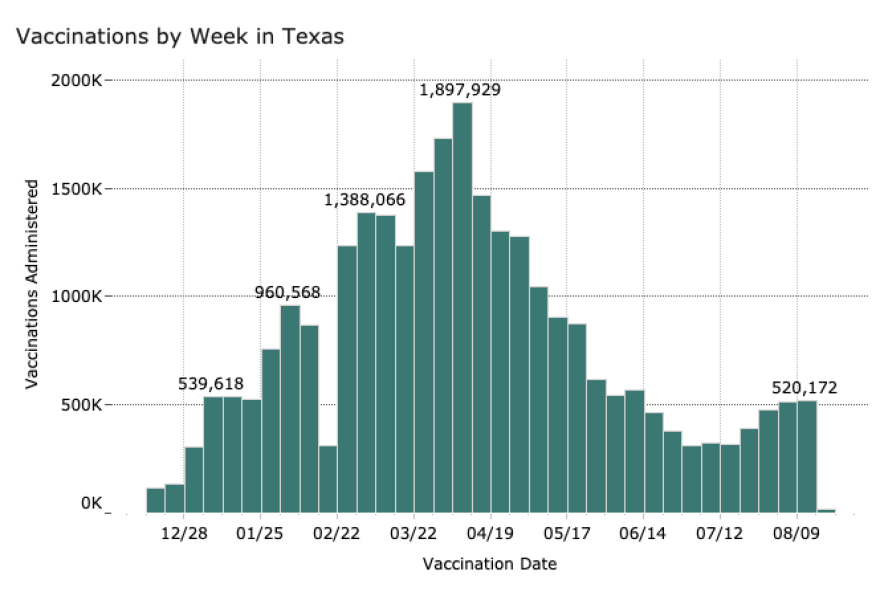The delta variant has become the dominant strain of COVID-19 in Texas, triggering an alarming surge in deaths and hospitalizations that has largely affected the unvaccinated.
But state data show that one encouraging metric has also gone up in the last few weeks: vaccination rates.
The state’s vaccination rate reached its peak in the spring, according to the Texas Department of State Health Services' vaccination dashboard. Nearly 1.9 million vaccine doses were administered in the second week of April.
Rates had been declining ever since and plateaued in July. About 315,000 doses were administered from June 28 to July 4 — a decline of 83% from the state’s best week.
But vaccination rates have been picking up in the weeks since then. More than 1.9 million doses were administered in the state in the last four weeks, including more than 520,000 last week, according to the most recent data available.

The trend is reflected in some of the state’s most populous counties. From July 19 to Aug. 15, 352,505 doses were administered in Harris; 178,938 in Dallas; 128,292 in Bexar; and 73,904 in Travis.
Texas Department of State Health Services spokesperson Douglas Loveday said more people have gotten vaccinated as they’ve learned about the dangers of the highly contagious delta variant.
“We’ve worked to raise awareness of the current situation, and people seem to be heeding the call,” Loveday said. “More people are also aware of the delta variant’s presence in the state and the fact it is more transmissible. Additionally, many people who may have put off getting their vaccination, perhaps because they are young and healthy, are now recognizing the increased chances for infection from this delta variant.”
However, with only 45% of the state's population fully vaccinated, millions remain at risk. About 2.6 million Texans are partially vaccinated and more than 13.3 million remain unvaccinated.
Hospital administrators across Texas have said more than 90% of COVID-19 hospitalizations are unvaccinated patients.
The surge in hospitalizations combined with a shortage of qualified personnel has overwhelmed Texas hospitals and brought some near the brink of collapse, administrators told legislators last week. ICU beds have become in short supply across the state, with care providers expressing particular concern for the high number of pregnant women requiring intensive care treatment since the most recent outbreak began.
The spread of the delta variant has also prompted local governments, courthouses and school districts across the state to require people to mask up once again, going against Gov. Greg Abbott’s order banning mask mandates.
That includes Austin and Travis County, where officials have issued orders requiring most people to wear a mask when they visit city and county buildings, public schools and public colleges. Several school districts in Central Texas have also restored mask rules.
Copyright 2021 KUT 90.5

